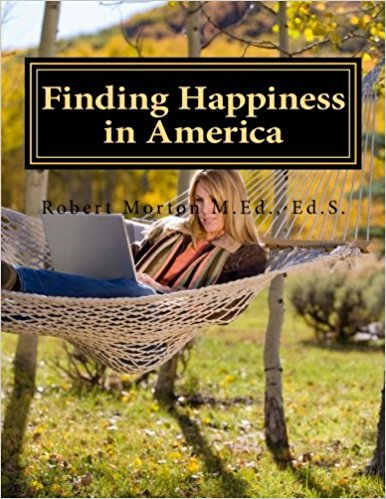America's children need to spend more time outdoors, relating to nature. In fact, 88 percent of kids say they like being in nature and 79 percent wish they could spend more time there.
 |
| The "Finding Happiness in America" manual |
That's why getting outdoors and getting back to nature for children, parents...all adults...is mentioned as one way to find happiness in the "Finding Happiness in America" (Kindle edition- click HERE) manual.
Nature deficit disorder exists in both children and adults in America. Our population has shifted to urban and suburban environments, and people are working longer hours and have busier schedules than ever before. The result is that the American family has a lack of awareness of—or access to—nature...to see, hear, smell, feel and touch the flora and fauna that envelops the earth.
The "Finding Happiness" process in the manual describes how Americans can get back to nature in their own suburban or urban yards. For example, I once witnessed a three-year old becoming more spellbound by a tiny, green worm inching it’s way across the front sidewalk than by a $600 swing set set up in the backyard. Creating a wildlife-friendly space in your yard will attract bees, butterflies and other insects along with songbirds that feed upon them. l
 |
| Complements- Ad Council |
I recommend for parents to read the book "Last Child in the Woods" by environmentalist and author Richard Louv. He offers ways to combat NDD and believes that returning to nature would be a decisive step towards promoting the healthy development, self-confidence and the ability to learn in America's youth.
Unfortunately, the bond between America's children (and adults) and nature has been severed and Louv, after interviewing educators, psychologists and scientists, argues that a number of physical and mental problems that children have are rooted in their lack of contact with nature. He links the high number of overweight children in the US, the increasing frequency of attention deficit/hyperactivity syndrome along with childhood stress, depression and anxiety disorders to the lack of contact with nature. Louv places a lot of faith in the healing power of nature through experiencing it with all one's senses under an open sky.
That's why getting back to nature is part of the "Finding Happiness" process in my manual "Finding Happiness in America" (Kindle edition- click HERE). Direct contact with the wilderness as well as a daily stroll through the neighborhood park, building a tree house or staying in a cabin will strengthen a child's self-esteem, his personality and his learning aptitudes such as reading ability. According to Louv, only people who have strong contact with nature from an early age can be respectful and protective of it as adults.
For little children, a few trees make up a forest and a puddle can offer a window into a natural habitat. Lift a stone to find the ground teeming with bugs or observe the life of squirrels in city parks, Louv suggests. Children can work in the garden, go on hikes to places that are seldom visited or go on hikes at night. Children should have fun discovering nature and allow themselves to be amazed by it and respect it.
Yes, climbing trees and catching frogs without concern for kidnappers or West Nile virus is difficult for many kids in America to do. The carefree days are gone for America’s youth. Boys and girls now live a "denatured childhood" where children spend less time outdoors and have less access to nature. In the "Finding Happiness in America" manual (Kindle edition-click HERE), I comment on how our youth is addicted to electronic media and how more and more green spaces are cemented over and developed into strip malls.
 |
| Complements- Ad Council |
America has seen open meadows, woods and wetlands replaced by manicured lawns, golf courses, endless strip malls and housing developments, separating us all from the natural world. What little time kids spend outside is on designer playgrounds or fenced yards and is structured, safe and isolating. Such antiseptic spaces provide little opportunity for exploration, imagination or peaceful contemplation.
Theodore Roosevelt saw a prophylactic dose of nature as a counter to mounting urban malaise in the early 20th century, and others since have expanded on the theme. He was so right! So, as described in the "Finding Happiness" process in my "Finding Happiness in America" manual (Kindle edition- click HERE), here's an activity to do...right now! Reacquaint yourself to nature. Go on a hike, fish, bird-watch...anything to reunite yourself with nature. Enjoy!
Robert Morton, M.Ed., Ed.S. has retired from his positions as school psychologist and adjunct professor in the School of Leadership & Policy Studies at Bowling Green State University. He authors the book, "Finding Happiness in America".(Click HERE for Kindle edition).



